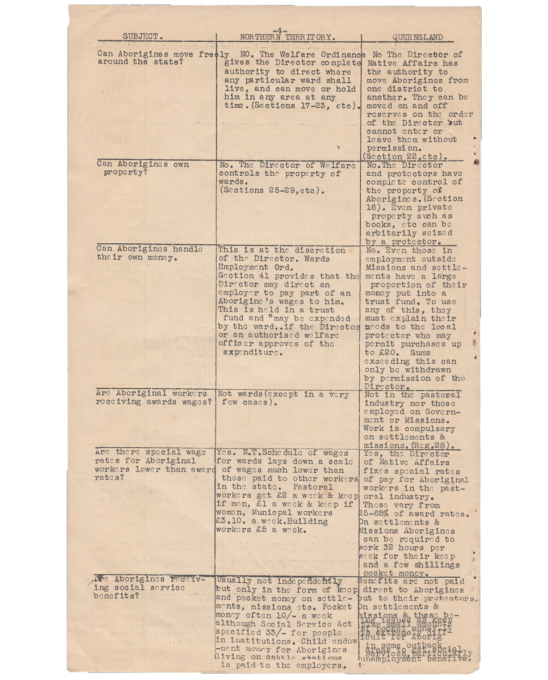
Leaflet shows different laws for Aboriginal people across states
A leaflet calling for Aboriginal affairs to become a federal government responsibility showed how state-based laws that governed Aboriginal people differed and led to inequality.
Queensland ... Benefits are not paid direct to Aborigines but to their protectors … It is extremely difficult for Aborig[ines] in some outback areas to get social services.
| Attachment | Size |
|---|---|
| fcaa-leaflet.pdf | 5.93 MB |
| Attachment | Size |
|---|---|
| fcaa-leaflet-plaintext.docx | 55.41 KB |
Before the 1967 Referendum, the states managed Aboriginal affairs and governed their rights. Each state and territory had a different approach and different laws.
The Federal Council of Aboriginal Advancement (FCAA, later FCAATSI) was a key group who fought for Aboriginal civil rights. As part of their campaigns, they published information about Aboriginal rights, including this leaflet A summary of their situation.
Written by organiser Shirley Andrews, this piece calls for Aboriginal affairs to become a federal government responsibility.
In a table, Andrews gives an overview of the different laws and rights Aboriginal people had under each state and territory. It includes information about rights to move, marry, raise children, vote, earn award wages, handle money, drink and own property.
There were some details left out. Andrews explained that Torres Strait Islander people were governed by the Queensland government under similar laws, although details about these laws were not included in the table. Tasmania and the Australian Capital Territory were not included as columns.
The table shows just how much control the states had over the lives of Aboriginal people. Andrews writes that many of the state laws are ‘restrictive and discriminatory’.
The leaflet also includes information about whether Aboriginal people in different states got their government payments directly. It shows how this varied from state to state. For example, in New South Wales, most Aboriginal people got their payments directly. However, in Queensland and the Northern Territory, it was common for the government to pay protectors, settlements and missions. Only part of this money then went on to Aboriginal and Torres Strait Islander people as ‘pocket money’.
The leaflet was cheaply reproduced for wide distribution and was updated over the next few years to capture changes to state laws. Andrews’s evidence shows it was important to change the constitution so that Aboriginal and Torres Strait Islander affairs could be managed at the federal government level.
While the constitution was changed following the 1967 Referendum outcome, the states continued to be involved in social services delivery and this caused continuing inequity in how, and whether, people got payments.
This digitised version of the leaflet was supplied by AIATSIS, which holds a copy in their collections.
Another copy of the 1962 leaflet is available through the Collaborating for Indigenous Rights 1957–1973 website hosted by the National Museum of Australia. Find it under ‘Resources: Social Service benefits 1954–64’.
Citation
Andrews S (1962) The Australian Aborigines: a summary of their situation in all states in February, 1962, Federal Council for Aboriginal Advancement, Adelaide.
